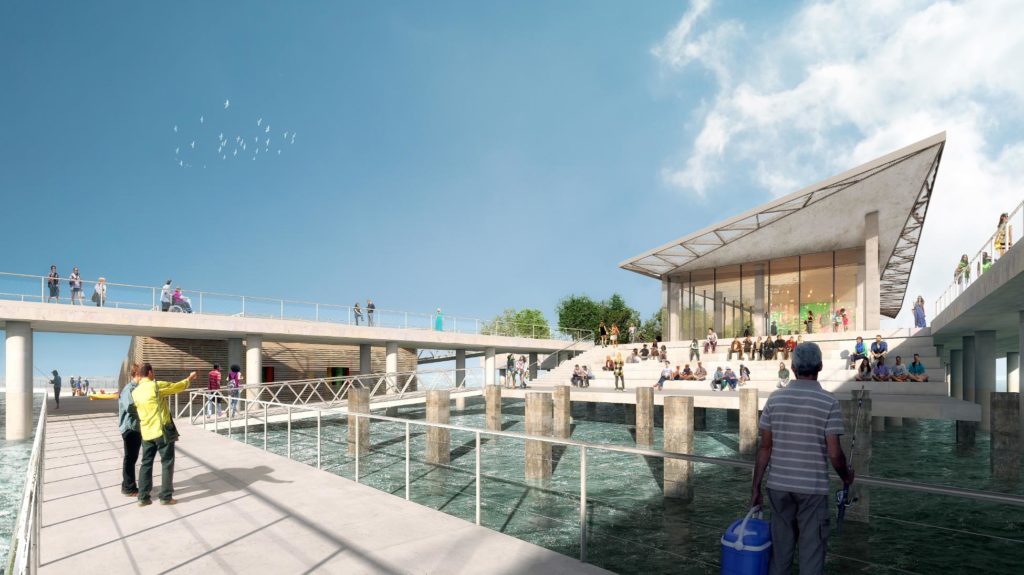
The Pier has been a staple of St. Petersburg for over 125 years, but the city has a history of recreating the icon every now and again.
Most recently, an inverted pyramid-style pier sat at the end of Second Avenue NE. Constructed in 1973 and demolished in 2015, the city now hopes to replace the attraction with something more imaginative.
A redesigned pier is one of the many projects Mayor Rick Kriseman took on shortly after being elected in 2014. However, development has been met with heavy criticism from those who believe the city’s money would be better put to use elsewhere, such as the city’s aging sewer system.
“Bond laws and regulations require the city to spend the proceeds of tax-exempt debt issues on the projects described in the offering statement,” said Kriseman. “In simple language, it means that we bonded to build a pier, we have to use the money to build a pier.”
If the city were to back out from its agreement with the bondholders and not follow through with the $66 million dollar project, it would cost the city $35 million, with no pier to show for it.
“It’s estimated that it would cost the city $35 million to not have a pier, which, to me, makes no sense,” argued Kriseman.
The mayor also stated that it is impossible to negotiate the terms of the the bond with the bondholders. Kriseman equated the scenario to taking out a mortgage on a home and then asking the bank if you could spend $50,000 of that money on a new car.
Despite the legal and contractual obligations on the loaned money, opponents of the new pier have criticized Kriseman for allowing the price of the project to continue to rise.
As it stands, $46 million would pay for the pier alone. An extra $20 million would be applied to the pier approach area, but Kriseman hopes to improve on the overall product.
In December, Kriseman lobbied City Council for another $14 million to expand on features included in the pier design. Kriseman says this is the last expansion he would ask for, though he has yet to formally announce his request to Pinellas County.
This money would come from tax increment financing funds that were set aside for 2014’s failed Greenlight Pinellas transportation system and would go toward the gateway plaza, a water recreation area, a family-friendly shaded plaza and public art.
Kriseman has said that the expansions aren’t necessary and that he would be content opening the pier as planned. He says the most important part of the project to him is creating a space for all St. Petersburg residents.
“It’s the right thing to do. It’s a part of our history. It’s a place for everyone in our city to gather.”
Pilings for the new pier are expected to be put down in May.
Kriseman remained firm in his recent 2016 State of the Economy presentation.
“We’re going have a pier,” Kriseman said in December. “We are going to build a pier.”
The design for the new pier, finalized early 2016, is called the Pier District. Construction is slated for completion by the end of 2018, with a grand opening in early 2019.
Plans include a 3,065 foot stretch of development made up of two parts: the pier and an approach that links the pier to the downtown area.
The new pier will retain the multi-level observation deck overlooking the water, as well as bars, seating terraces, a lawn, a tram stop and restaurants. Kriseman says that there will not be as many restaurants as there were previously.
The pier approach will consist of various activity areas such as a gateway plaza that will mark the beginning of the new space. The plaza will be followed closely by a market space for small outdoor shops.
Other pier approach features include picnic and park areas on the eastern side of the peninsular stretch near Spa Beach. Existing plans also include restaurants and boat docks on the western side.
Information from the Tampa Bay Times and NewStPetePier.com was used in this article.
http://www.newstpetepier.com/
http://www.newstpetepier.com/history.php
https://en.wikipedia.org/wiki/St._Petersburg_Pier



